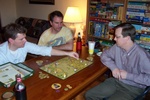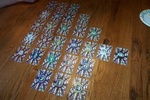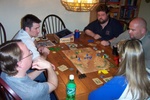
March 24, 2004Session Report for March 18, 2004by Susan Rozmiarek
Mike Chapelís Adam Spielt order finally came in, and he arrived carrying an impressive pile of new games. I was very happy to get to try two of them, both soon to be released in English editions by Uberplay. Oh, PharaoFirst off, I have to complain that the spelling of the title, even if it is the correct way to spell it in German, drove me nuts. For this reason alone, I will make sure to get the Uberplay edition. And yes, I do want a copy as I really enjoyed this game.This is another pyramid building game, this time using cards. The cards are numbered and are the building blocks for pyramids that a player builds on the table in front of him. The pyramids must be built according to certain rules. Blocks (cards) on each level must be of the same number and levels must be numbered sequentially with the lowest being on the bottom. Levels must also contain at least one block less than the level below them. Pyramids will be scored during the game by adding the face value of each level (one block) and multiplying by the number of levels. Then the pyramid is discarded. On a playerís turn he may do the following actions in order: 1. Score pyramids in front of him (optional) 2. Draw a card from either the draw pile or choose one of three face-up cards 3. He then may do the following in any order: Build a new pyramid or add on to an existing one Trade cards with other players Play action cards 4. Lastly, he draws back up to a hand of seven cards. He can optionally discard one card first. The neatest action card is a Thief. This card allows you to try to steal a card from another playerís pyramid. You roll a dice to attempt this and if you roll equal to or greater than the number of levels on the pyramid, you get to choose a card to steal and add to your hand. An evil thing to do is to choose a card on the bottom of the pyramid, removing the support of the cards above it, which must be removed and returned to the playerís hand. This reminded me of The Bucket King. It forces you to make some decisions about when to score your pyramids. The longer you leave them out and add to them, the more points they will score, but players will target them with Thief cards to knock them down to a smaller size. On the other hand, the larger the pyramid, the harder it is for a Thief to be successful. The other action cards are the Tax Collector, which allows you to randomly draw a card from the hand of each player, and Pharaoh cards, which counter the Thief and Tax Collector cards. Additionally, there are wild cards in the deck, which can be played as blocks of any number. The other component of the game is the track. Each time a pyramid is scored, a marker is moved one space along a time track. When the marker gets to the last space, the end game phase starts. In addition, there are a few spaces on the track that trigger certain conditions. At first, players are only allowed to build one pyramid at a time. After a certain spot is reached along the track, they may build up to two. Another spot requires that all pyramids must now be a minimum of three levels to score. Our game was fairly short and a lot of fun. Itís a light game and perfect for a filler. Mike was able to score an impressive 120-point pyramid. Results: Mike 250, Doug 215, Susan 204, Jeff 98.
HansaNext up was another upcoming release by one of my favorite designers, Michael Schacht. This is more of a gamerís game, and it took me a while before I saw how the mechanisms related to each other and flowed.The game is set in the 14th century in the Baltic Sea region. The idea is to collect goods and sell them at markets for victory points. The board is a map depicting the region, with various cities and fixed sea routes between those cities for the merchant ship. All players will be using this single ship and on their turn they can pay to sail the ship and perform one action in each city they visit. They may go as far and do as much as they want, as long as they can pay. It costs one coin to move the ship to a city, always following the routes, with a few cities having a choice of routes from which to choose. Players get three coins from the bank at the start of their turn. At each city they visit, players can choose to do one of the following actions (or none at all): 1. Buy a goods marker. These come in several colors and have 1-3 barrels on them. Each city starts the game with one or two of these markers (randomly placed). Before the start of his turn, a player may opt to replenish the board with goods markers. These are in five facedown stacks. Doing so costs one coin. Buying a goods marker from a city costs one coin. The coin is paid to the player who has a majority of markets in that city or paid to the bank if nobody has a majority. Of course, if you have the majority, the marker is free. 2. Establish markets. These are represented by discs in each playerís color and are in limited supply. To establish markets the player must turn in one goods marker. He then places as many markets in that city as there are barrels depicted on that goods marker. 3. Sell goods. A player may only do this at a city in which he has at least one market and goods must be sold in sets of at least two of the same color. He takes back one of his markets and this allows him to sell as many sets as he can. He turns the goods markers facedown in front of him. These will be victory points at the end of the game. There is one painful thing about this action for the other players. When goods are sold, all other players must discard a marker of that color if they have a face-up one. So, it is important to carefully watch what other people have and can do on their next turn so that you donít lose goods before you have a chance to use or sell them. Players can only carry over three coins and three goods markers to their next turn. No hoarding allowed! Play continues until the last stack of goods markers is needed to replenish the board. Then the current round is finished and players count their victory points. Each facedown goods marker is one point plus a point for each barrel depicted. Face-up markers count as one victory point only. In addition, a player gets 2 victory points for each city in which he has a market and 4 points for each city in which he has the only market. The player with the most points wins. Money is very tight. You often do not have enough to sail the ship to the desired city and you will have to consider where you leave the ship relevant to what the next player can do with it. You also may find the ship has been left in an area that has been depleted of goods markers and youíll have to pay to replenish the board to get any. The only way to make money beyond your normal income of three coins is to have a majority of markets in cities with desirable goods. However, you must pay for your markets with a goods marker that may have already cost you a coin to buy. Youíll also be losing markets as you sell goods, perhaps losing the majorities as well. On one hand, youíll want to save goods markers to sell for victory points, but on the other hand, you need markets to sell them. So, youíll have to give up some markers to build markets, while collecting others for selling, all the while hoping and planning for routes that allow you do it all. Confused yet? So was I. Lots of planning and angst here as you are constantly reevaluating your situation based on where the ship was left at the start of your turn and what goods others have picked up. Despite my initial confusion, I eventually figured out how the various components of the game meshed together. The game seems to develop a certain tactical rhythm to it, with a little long-term strategy thrown in. A couple of the cities are much harder to get to due the way the sea route is configured and it took me a while to figure this out, getting very frustrated in the process. All of us were very impressed with the game and Doug likened it to Logistico, proclaiming that Hansa was the superior of the two. I didnít quite see the similarities between the two games, other than the pick-up and delivery aspect, and I think both are very good. Results: Susan 44, Doug 36, Ed/Mike 31
Other games played: Pompeji, Trendy, Oasis
For more pictures from this gaming session and others, see our Gaming Picture Gallery. Posted by Susan Rozmiarek at March 24, 2004 2:26 PMComments
Post a comment
This page viewed E-mail Ed Rozmiarek with questions or problems concerning this page. Copyright © 2004, Ed & Susan Rozmiarek. |





